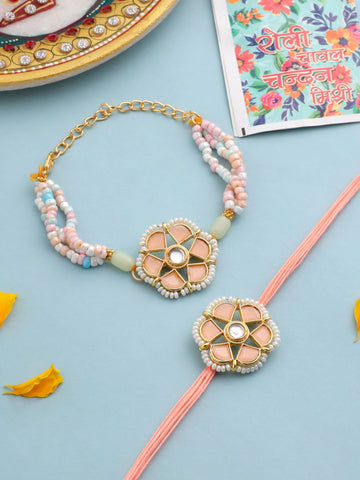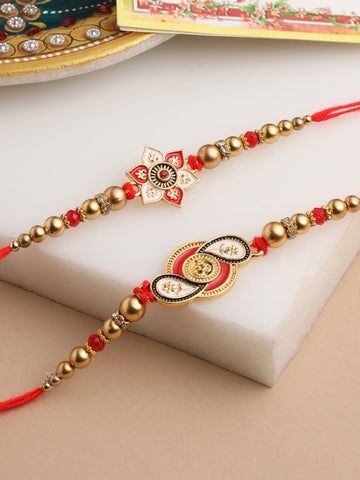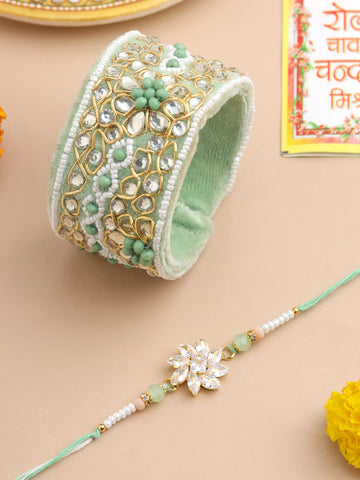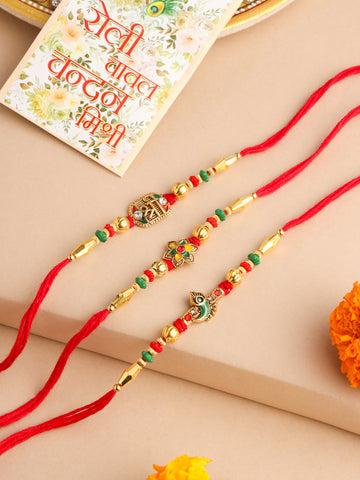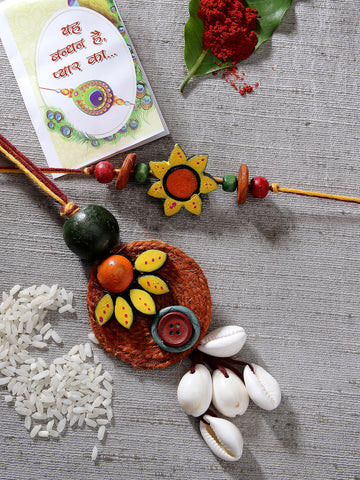
Bhaiya-Bhabhi Rakhi: A Celebration of Love, Bonding, and Tradition
The festival of Raksha Bandhan, commonly referred to as Rakhi, is an annual celebration in India that highlights the bond of love and protection between siblings. Traditionally, this festival involves a sister tying a sacred thread (rakhi) around her brother’s wrist, symbolizing her love and prayers for his well-being, while the brother pledges to protect her throughout his life. While the festival is deeply rooted in sibling relationships, the Bhaiya-Bhabhi Rakhi, a variation of the traditional Raksha Bandhan, holds unique cultural and emotional significance. It extends the spirit of Rakhi to include not just brothers but also their wives (bhabhi), reinforcing the collective nature of familial bonds and the celebration of unity within a family.
Historical and Cultural Context of Raksha Bandhan
The origins of Raksha Bandhan are steeped in Indian mythology and folklore. One of the most popular stories relates to the bond between Lord Krishna and Draupadi. According to legend, when Lord Krishna cut his finger, Draupadi tore a piece of her saree to bandage his wound. In return, Krishna vowed to protect her when she faced the humiliation of being disrobed in the Kuru court. This symbolic act of protecting one another became the foundation for Raksha Bandhan, where the sister ties a rakhi, and the brother, in turn, promises to protect her.
Over time, the festival has evolved, encompassing a broader range of relationships. The Bhaiya-Bhabhi Rakhi is a modern extension of this concept. It not only strengthens the relationship between siblings but also acknowledges the role of the sister-in-law in the family. Rakhi is no longer just a brother-sister affair but a broader celebration of familial unity.
Significance of Bhaiya-Bhabhi Rakhi
In the context of Bhaiya-Bhabhi Rakhi, the bond between the brother and sister-in-law is highlighted and celebrated. The brother, along with his wife, becomes a central part of the Rakhi celebration, with the sister tying a rakhi on both of their wrists. This act is symbolic of acknowledging the support, affection, and love that both the brother and the bhabhi offer in the family. For many women, this bond is significant as it marks the acceptance and inclusion of the sister-in-law into the sibling's world, fostering deeper emotional ties and mutual respect.
In many families, the bhabhi plays a pivotal role in maintaining family harmony and strengthening ties between family members. By including the bhabhi in Raksha Bandhan celebrations, the sister acknowledges the important role that she plays in the family dynamic. This inclusion also deepens the emotional bond between the sisters-in-law, who, often due to the familial setup, might not share the same history or memories that siblings do. Yet, with the sister’s gesture of tying rakhi to her bhabhi, this bond becomes more meaningful and special.
The Symbolism of Rakhi in Bhaiya-Bhabhi Rakhi
Rakhi, the sacred thread, is more than just a decorative piece; it carries profound symbolic meaning. The tying of the rakhi represents protection, love, and prayers for the well-being of the wearer. For the brother, it is a reminder of his responsibility to protect his sister and, in the case of Bhaiya-Bhabhi Rakhi, his wife as well. On the other hand, for the sister, tying a rakhi on her brother’s wrist symbolizes the trust and belief that she has in him to fulfill that promise of protection.
The rakhi also holds cultural significance. Traditionally made with cotton threads or silk, sometimes adorned with beads, gems, or a small charm, it serves as a token of the bond that transcends material possessions. The color of the rakhi can vary, but it is often vibrant, representing joy, festivity, and the enduring connection between siblings. The inclusion of the bhabhi in the Rakhi ritual further enhances the importance of these symbols, making them a collective part of a shared family experience.
The Role of Family Traditions in Bhaiya-Bhabhi Rakhi
Family traditions play a crucial role in the celebration of Bhaiya-Bhabhi Rakhi. Every family has its own customs, rituals, and practices, which evolve over time but retain their significance. In some households, the sister-in-law may offer sweets, gifts, and blessings to the sister during the Rakhi ceremony. This practice not only solidifies the bond between the siblings but also fosters a sense of inclusivity and unity in the family.
Moreover, in some families, the brother and sister-in-law may exchange gifts to express gratitude and affection. This exchange reinforces the notion of mutual respect and the nurturing of relationships, which is integral to the festival. In many cases, the brother may take his sister and bhabhi out for a celebratory meal, or the family may gather together for a feast, further enhancing the feeling of togetherness and love.
Emotional and Social Impact of Bhaiya-Bhabhi Rakhi
The emotional impact of Bhaiya-Bhabhi Rakhi is immense. It nurtures not only the relationship between siblings but also the relationship between the extended family members. The sister-in-law, who is often a newer addition to the family, finds a deeper connection with her husband’s family through this shared celebration. It is a way of making her feel welcome and appreciated, particularly in traditional settings where the bond between a wife and her in-laws is often complex.
For the brother, the act of receiving a rakhi from his sister and his wife can be deeply meaningful, as it signifies love, respect, and care from both sides. In a sense, it is a unifying gesture that helps create a sense of togetherness within the family, bridging any gaps that may exist between the siblings, the brother’s wife, and the extended family.
Bhaiya-Bhabhi Rakhi in Contemporary India
In contemporary India, the concept of Bhaiya-Bhabhi Rakhi has gained popularity as families evolve and become more integrated. The changing family structure, with a focus on the nuclear family, has shifted the way siblings and extended family members relate to each other. The inclusion of the bhabhi in Rakhi celebrations is an acknowledgment of the growing importance of inclusivity and mutual respect in modern family dynamics.
This modern take on Raksha Bandhan is not just about protecting one another in the literal sense, but also about providing emotional support, understanding, and respect for each other. The bond between a brother, his wife, and their sister-in-law is an example of the evolving familial relationships that emphasize love, respect, and togetherness over tradition alone.
Conclusion
Bhaiya-Bhabhi Rakhi is a beautiful extension of the traditional Raksha Bandhan festival, symbolizing the deep bonds of love and protection that exist within a family. It is an expression of mutual respect, trust, and commitment between siblings and their spouses. By including the bhabhi in the Rakhi celebration, the festival transcends its traditional boundaries and embraces a broader sense of family unity. In today’s world, where familial ties are increasingly complex, Bhaiya-Bhabhi Rakhi serves as a reminder of the importance of nurturing relationships and celebrating the collective strength of the family. It is not just a ritual, but a heartfelt occasion that reinforces the values of love, support, and togetherness, making it a cherished tradition for generations to come.

